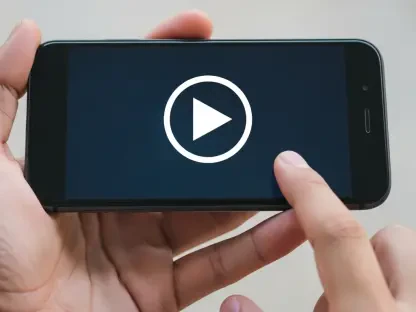In today’s saturated digital landscape, merely creating great content is no longer sufficient to stand out. With millions of blog posts and hundreds of hours of video uploaded daily to platforms like YouTube, LinkedIn, and Instagram, the challenge now revolves around effective distribution strategies. Without strategic amplification, even the most high-quality content risks becoming invisible amidst the overwhelming competition. Content creators and businesses alike must shift their focus from creation to distribution to ensure that their message reaches the intended audience. This evolution demands a comprehensive understanding of what platforms prioritize and how best to leverage them for maximum reach and engagement. Moving forward, it is not just about the originality of the content but the ingenuity and breadth of its dissemination. In the following discussion, the importance of distribution over creation and practical strategies to master this art will be explored.
1. The Content Glut: Why Even Great Content Gets Ignored
The digital era has ushered in an information overload, with staggering amounts of content produced every minute. Whether it’s 7 million blog posts published each day or 500 hours of video added to YouTube every sixty seconds, the sheer volume on social media channels like LinkedIn, Instagram, and Twitter makes standing out an arduous task. Quality content without a definitive distribution plan is akin to shouting into a void, where impactful messages get lost in the disruptive noise. For entities attempting to capture audience attention, understanding the need for amplification across various networks is essential. The fundamental takeaway here is that visibility requires strategic distribution. Brands must ensure their content is not only seen but engages effectively with their target market to drive results, which involves creating pathways for content to be accessed repeatedly across multiple channels.
With the prevailing algorithms of leading platforms, emphasis falls on aspects beyond just content quality. They reward consistency and a broad presence across distinct digital spaces, proving that frequent interactions often trump singular in-depth contributions. This decentralized approach to content dissemination explains why engagement velocity—involving how quickly content is shared or responded to—significantly enhances reach. Cross-platform syndication allows content to reverberate far and wide, short-circuiting isolated consumption and fostering continuous audience interaction. Businesses refining their distribution matrix observe boosts in performance through repurposing and reallocation efforts, converting one-time creations into ongoing dialogues with their audience. As businesses navigate this terrain, those willing to adapt to these new realities find themselves ahead in the crowded field, where distribution practices complement content efforts.
2. Distribution > Creation: What Platforms Actually Reward
Current platform algorithms exhibit specific characteristics that favor diversified content distribution strategies over traditional content creation. The focus now lies on consistency, presence across varied platforms, and engagement velocity. These have become critical factors in determining a content’s success. Modern platforms like Google through its EEAT update and LinkedIn prioritize distributed content that manages to captivate and re-engage audiences through rich experience and expertise. Engagement and activity foster continued attention, which builds momentum as varying platform dynamics initialize audience interaction. Quality retains its importance, but visibility secures greater priority. If content is unseen, its potential impact diminishes significantly.
A real-world demonstration of effective distribution materializes in a SaaS company’s strategy, where turning a singular blog into multiple formats across diverse platforms manifested significantly increased engagement metrics. Deriving content into distinct forms such as LinkedIn posts, Twitter threads, Medium articles, YouTube Shorts, and newsletters creates a multifaceted interaction channel for shared information. This strategic approach generated five times more traffic and tripled conversions compared to methods that neglected distribution. Influencers deploying these distribution tactics found repurposed content outperformed newer creations simply by leveraging timing and optimal format adaptation. Businesses remain eager to tap this attractive framework, redirecting their strategy towards ensuring that quality output encounters as many eyes as possible through an amplified distribution network. The distribution-focused mentality reshapes marketing landscapes, with companies reengineering their approach towards a more holistic audience capture.
3. Real-World Proof: Distribution in Action
The practical application of distribution-focused strategies offers compelling evidence of its efficacy. A case study involving a B2B SaaS firm demonstrates how successfully crafted distribution plans can outperform simple content creation efforts. By taking a single blog post and distributing it thoughtfully across multiple digital platforms—such as LinkedIn, Twitter, Medium, YouTube, and via newsletters—the company managed to magnify its digital footprint. The translation of different content types, spanning from single posts to a series of comprehensive threads or short video snippets, cultivates a broader scope of engagement opportunities, often leading to increased traffic and conversion rates.
Examining influencer strategies further exemplifies successful tactics in content repurposing and adaptive distribution. An aged tweet, revitalized in creative formats such as carousel posts, achieved remarkable traction—outperforming new content by 37%. Such results showcase the strength of strategic timing and agile content adaptation. Correctly positioning older content in refreshed formats aligns with current audience preferences, demonstrating that thoughtful repurposing overrides the need for continuous novelty. Distribution turns older content into evergreen entities, constantly evolving with audience inclination and platform demands. The dynamics of a well-distributed content plan generate applause from sectors continuously seeking impactful engagement strategies, streamlining outreach and decision-making processes essential for surviving modern digital ecosystems.
4. Step-by-Step Guide: How to Build a Winning Distribution Plan
Crafting a successful distribution strategy involves strategic guidelines to maximize the impact. Step one focuses on auditing existing content by identifying previous high-performers across blogs, videos, and other assets. This step provides insight into what content resonates with the audience and offers a solid foundation for distribution efforts. Selecting appropriate distribution channels is pivotal, with choices ranging from LinkedIn, Twitter, YouTube Shorts, Medium, Substack, and Quora. Each platform serves distinct purposes and offers unique audience engagement methodologies.
The next essential step is the repurposing of existing content into multiple formats appropriate to different platforms. Transforming a blog into a carousel, video, thread, infographic, or any combination thereof exponentially enhances reach and interaction. Scheduling with tools, such as Buffer, SocialBee, or Missinglettr, enables multi-channel automation that eases operational management and assures timely delivery. Monitoring performance and refining strategies allow adaptability to current trends and audience preferences, ensuring optimization of high-performing content on a monthly basis. As content circulates effectively across multiple channels, its potential amplification grows, forming a comprehensive reach strategy indispensable in modern digital marketing.
5. Tools That Make Distribution Easier
Various tools greatly facilitate the complexity of distribution, each offering unique functionalities that streamline the content amplification process. BrandPush offers distribution services across over 300 media sites, including Google News, expanding brand visibility significantly. Outbrain and Taboola specialize in native ad distribution, effectively placing content in a natural, unobtrusive manner within the functions of different platforms. CoSchedule acts as a smart calendar and social automation tool, easing the scheduling process while keeping management manageable.
Ocoya leverages AI capabilities for content repurposing into snippets and headlines, ensuring consistent yet adaptive presence across multiple platforms. These technological aids simplify the multifaceted distribution efforts, providing tools that support businesses in reaching wider audiences. Selecting suitable tools allows companies to efficiently manage the diverse needs of distribution plans across platforms, nurturing engagement and building brand equity. With such resources, optimizing content visibility becomes attainable, offering businesses an edge in an increasingly digitized marketplace. The complexity of content distribution finds itself less daunting, with organizations empowered through technological integration.
6. The 70/30 Rule for 2025
Prevailing models of content strategy have undergone significant transformation. The traditional approach, which allocated 70% of resources to creation and 30% to promotion, now sees a distinct reversal. The paradigm for success currently calls for investing 30% into content creation while dedicating 70% to distribution efforts. Recycled content, when strategically shared across multiple channels, often exceeds the outreach results of brand-new pieces. Emphasis on adept distribution ensures content repeatedly engages with its audience, feeding consistent attention and interactions that further amplification aims.
Industry influencers, such as Neil Patel, advocate for a distribution-centric strategy that outperforms conventional models by reprioritizing shared content over constant freshness. The 70/30 rule affirms content’s journey does not end with creation; instead, its promotion via an integrated distribution plan determines ultimate success. Businesses prepared to redefine their efforts towards audience engagement through continued creativity share an experiential understanding of content impact. This strategic reassessment manifests growth in global interaction, reinforcing the importance of adaptable distribution against static production.
Conclusion: Circulate to Win
In today’s digital age, we’re deluged with vast amounts of content created every minute, such as 7 million daily blog posts or 500 hours of video uploaded to YouTube each minute. This overwhelming volume means that standing out on social media platforms like LinkedIn, Instagram, and Twitter is a formidable challenge. Creating high-quality content without a solid distribution strategy is like trying to be heard in a crowded room; messages can easily be drowned out by the relentless noise. For brands aiming to capture audience attention, recognizing the need for amplifying their reach across networks is crucial. The key takeaway is that visibility demands strategic distribution. Brands must not only ensure their content is seen but must also engage effectively with their target market, creating continuous pathways for content to be accessed across multiple platforms. With leading platforms’ algorithms, the focus shifts beyond quality alone to rewarding consistency and diverse presence. Adopting a decentralized approach enhances engagement velocity—how fast content circulates significantly boosts reach. Cross-platform syndication and refining distribution strategies foster ongoing dialogues and engagement, putting adaptable businesses ahead in a crowded landscape.









